How to Stop Airline Crews from Jeopardizing your Infant’s Safety
 Sunday, May 7, 2017 at 10:59PM
Sunday, May 7, 2017 at 10:59PM
That’s right. More than 50% of flight attendants I have encountered on 45+ domestic and international flights I took with my infant between 2015 and 2017 were not familiar with “infants in seat” regulations and tried to apply “lap infant” or “child in seat” safety regulations to my infant, thus violating FAA regulations and more importantly, jeopardizing her safety.
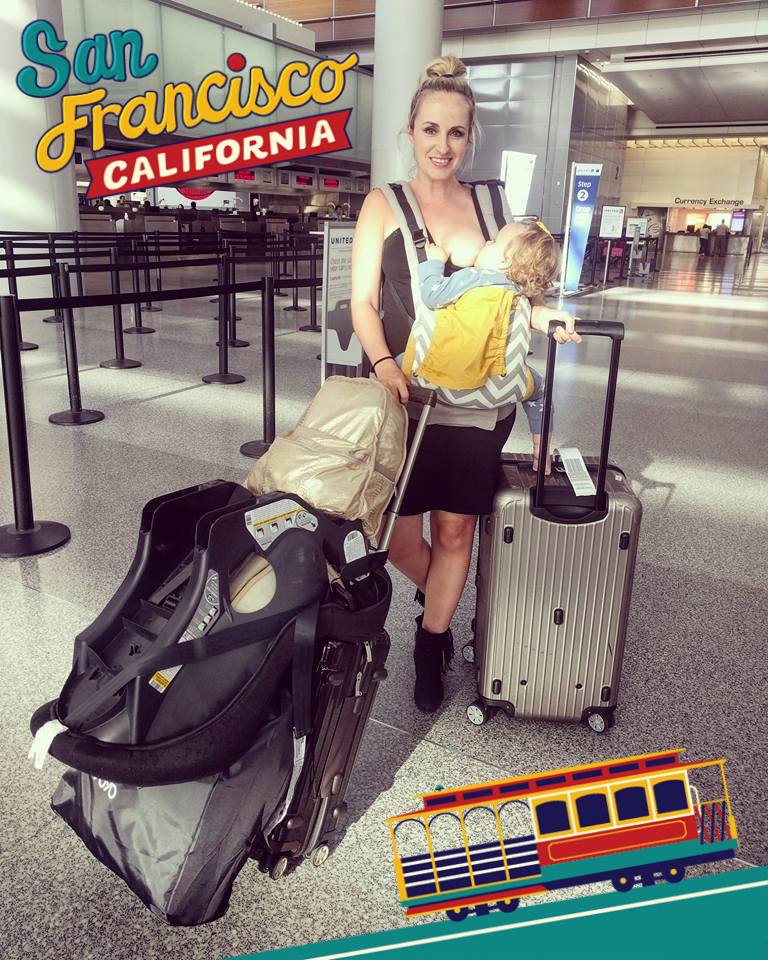
Hi there, I should probably introduce myself first. My name is Petra and I fly a lot with my daughter Luna (proof). Before she turned 20 months old, she visited Europe six times. She has flown to Cancun, Las Vegas, Atlanta, Tampa, Yellowstone, Boston, and visited some of these multiple times. She has flown with most major US and EU airlines, as well as charter airlines. She just turned two, which marks the end of a series of traumatizing arguments and incidents I had to get involved in in order to ensure that she got the same level of safety as any other passenger on board. I have learned a ton, and being a scientist by trade, I feel obligated to write a postmortem summarizing my experience and findings. Therefore I put together this guide for parents that want to fly with their infants in the most safe way possible.
Wait, there is more than one kind of kid?
- Lap infant a.k.a. lap baby is a baby under 2 years of age that does not occupy its own airplane seat. It rides on its parent’s lap. Lap babies on US based airlines aren’t allowed to use any child restraint system (CRS). Certain EU airlines require the use of a “loop belt” which attaches to parent’s lap belt but the loop belts have became illegal in the US (per FAA).
- Infant in seat is a baby under 2 years of age for which a parent/guardian purchased a ticket and therefore does occupy its own airplane seat. Seated infants are required to ride in a FAA approved CRS (a car seat) that must be installed according to car seat manufacturer instructions (for children under 2, this is 100% rear facing).
-
Child in seat is a child over 2 years of age that occupies its own airplane seat and might optionally use a CRS such as FAA approved car seat or CARES harness. They can also just sit in the airplane seat itself just like any other adult, and can be restrained only using the lap belt that adults use. Children that reached their second birthday are prohibited to ride on their parents lap (per FAA regulations).
The problem -- crews jeopardize infant safety in the following ways
- They tell parents to gate check the car seat. This is either because they do not have a window seat available for it (since FAA requires that car seats do not impede evacuation), or because they think that there isn’t enough space (width or length-wise) to install it on the assigned airplane seat.
- They tell parents to hold their infant on the parent’s lap for the entire duration of the flight, even though the parent purchased a ticket for the infant and brought an FAA approved car seat. This happened just few days ago to a California family flying with Delta from Maui to LA, where the seat was given to an adult, because the crew decided that they can carry more people if they put children on laps, completely disregarding their safety and violating FAA regulation that prohibits children (2+ years old) on laps.
- They allow parents to install the car seat but tell them to hold their seated infant in their lap for takeoff and landing (the most dangerous parts of the flight). This is probably because flight attendants have only been trained about “lap infant” safety and want to apply the same rules to “infants in seat”.
-
And lastly, the most common problem I encountered -- they tell parents of infants to turn a rear facing infant car seat (or convertible car seat) forward. This is probably because they have never seen a rear facing car seat installed on an airplane (remember, most parents choose to hold babies on laps to save money). I have also encountered concerns about the comfort of the passenger sitting in a previous row, mainly their ability to recline. This is the situation when the flight attendant declares that someone’s ability to recline is as important as your child’s safety, and you are left to argue against this logic. I lost this exact argument with KLM crew who first pulled out a terrorist card on my husband and then forced us to gate check the car seat.
What can happen during a crash or a turbulence if you are holding your baby in your lap?
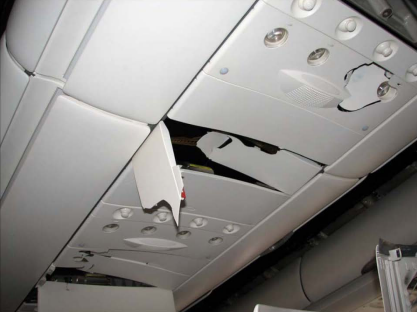 Damage caused by unrestrained passengers during turbulence
Damage caused by unrestrained passengers during turbulence
- During turbulence, your baby can hit the overhead bins or otherwise fly through the cabin. Keeping your baby in a Babybjorn or looping her in a that silly lap belt will not reliably keep her from flying up into the overhead bins. I did not find data on turbulence injuries in children but this report claims that turbulence has caused more serious injuries to passengers than any other class of accident. Between 1998 and 2013, there were 432 sigificant turbulence events. Annualy, there are about 27 events causing serious injury to 14 people and minor injury to 69 people. Turbulence rarely causes fatalities, however fatal events have occured in the past. The worst one happened near Mount Fuji in 1966 (124 fatalities). There were number of cases when babies were thrown up at overhead bins and landed away from the parents holding them. The most recent turbulence accident caused head unjuries to unrestrained babies on an Aeroflot flight to Bangkok just few days ago! This one was caused by sudden clear-air turbulence, where passengers did not get any warning to put on a restraint. There are around 750 cases of clear-air turbulence recorded in civil aviation every year. A five point restraint is crucial at preventing turbulence related injuries in children.
- During a forward crash, your body keeps moving forward crushing the anything between your chest/head and the back of the seat in front of you. It sounds horrible that parents might crush their own babies but it is a reality. A 22 month old lap baby died in 1989 on United Airlines flight which 183 people were able to escape and a 6 month old lap baby died in 2012 on Perimeter Aviation flight in a runway overrun crash.
-
During a crash or a turbulence, your baby can hurt or kill other passengers -- unrestrained objects (bags, laptops, babies) can fly through a cabin at high speed hitting everything in its way.
What can happen during an accident if you attached the infant car seat forward facing
The direction of the car seat installation does not seem to matter during turbulence, because the motions are mainly up and down. This is why the car seat installation direction is most important during takeoff and landing, when the chances of a forward crash are the highest.
- Findings show that before age two, none of the cartilaginous spaces in spinal column have completed ossification. Those pieces of cartilage have the ability to stretch up to two inches. Yet only 1/4″ stretch is enough to rupture the spinal column, resulting in paralysis or death (source). The average nine month old child’s head makes up 25% of her body weight; while an adult’s head only makes up 6% of her body weight (source). This difference in proportion only adds to the need to safeguard the spinal column in children.
- Roughly 60% of all vehicle crashes are frontal and 20% are side impacts (source). A study which compared injury statistics for 15 years worth of crashes involving children under age 2 concluded that the odds of severe injury for forward-facing infants under 12 months of age were 1.79 times higher than for rear-facing infants; for children 12 to 23 months old, the odds were 5.32 times higher (source). Putting a child in a rear facing car seat protect its neck and the entire spine from breaking during a forward crash.
- Spinal column isn’t the only part that can get injured if the car seat is turned forward. Since the car seat’s five point harness was set up for rear facing use in cars (the shoulder belts are in a slots at or *below* the child’s shoulders) your infant’s clavicle bones and/or shoulders can break during a crash. Imagine yourself in a car accident where your shoulder belt does not end above your shoulders but below your shoulders. As you fly forward, the shoulder belt will press down on your shoulders, possibly breaking them.
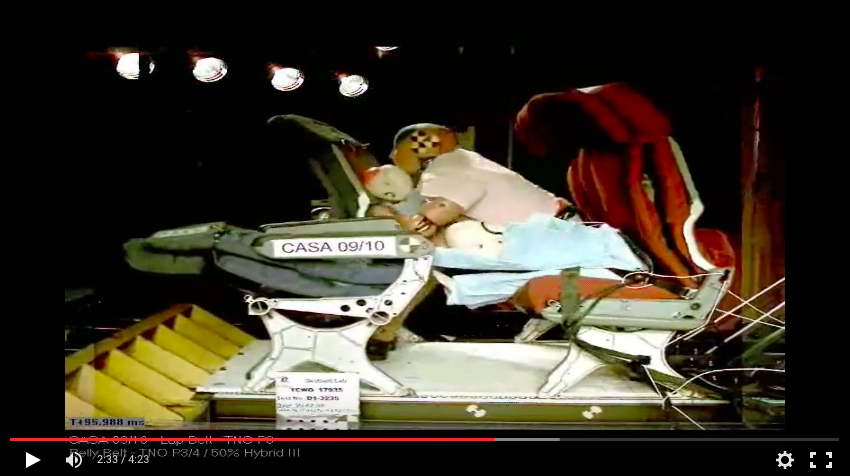 Infant crash test dummy video showing possible injuries to lap infants
Infant crash test dummy video showing possible injuries to lap infants
But why does FAA still allow lap babies?
According to FAA, and I’m quoting, “the safest place for your child on an airplane is in a government-approved child safety restraint system (CRS) or device, not on your lap”. Yet, FAA still allows lap babies. Why is that?
National Transportation Safety Board (NTSB) keeps begging FAA to require that all passengers, including infants, are restrained during take off, landing, and turbulence. However, FAA chooses to allow lap babies for a number of reasons, including the popular “Diversion to Automobile” argument which is described as: “Any increase in airline costs will lead families to divert to more dangerous modes, resulting in more deaths and injuries“
At a first sight, it looks like FAA is concerned about infant safety and had to make a tough decision of picking the lesser evil. However, detailed analysis of road accident data shows that this argument does not hold.
Here is the NTSB analysis and response to FAA’s “Diversion to Automobile” argument. Notable excerpts from this analysis follow:
-
...despite several Safety Board recommendations and ongoing lobbying efforts by concerned organizations including the Association of Flight Attendants and the American Academy of Pediatrics, and the 1998 Advanced Notice of Proposed Rulemaking by the FAA to require child restraints, there is still no requirement that children under 2 be protected by any form of restraint during flight….
-
...The resulting reality is that many of the approved safety restraints now used to transport infants to and from airports end up flying as checked baggage while those infants ride in the cabin unprotected....
-
...Because laboratory and real-world accident data have shown that lap-held children cannot be adequately protected, the age of the passenger becomes arbitrary. Choosing to continue to exempt children under 2 from an adequate restraint requirement is then no different from granting a similar exemption for any other segment of the passenger population….
-
...passengers are now required to securely stow all carry-on baggage during takeoff and landing because of the potential risk of injury to other passengers in the event of an unexpected hazard encounter. However, the same passengers are permitted to hold a child of equal size and weight in their lap. When children under 2 are not required to be restrained for their own safety, the safety of their fellow passengers also becomes an issue....
-
...there does not appear to be a clearly defined relationship between diversion from air travel and highway accidents or injury. In fact, despite the acknowledged difference in relative risk between road and commercial airline travel in the United States, and the largest diversion from air travel in U.S. history during recent years, road fatalities and injuries for children under 5 years old have continued to decrease…
As a parent, you need to understand that it is not everyone’s priority to keep your child safe. Airlines are for profit businesses and have different incentives than you. It is also noteworthy that even FAA is not only concerned about infant safety. In fact, their other arguments against NTSB’s safety recommendation were focused on the increased costs and lost revenue for airlines, and reduced ability to accommodate more non-infant passenger on the airplanes (as if infants were not worthy the seats).
The difference between US based and foreign based airlines… when it gets to infant safety
You do not need to read this if you do not plan to travel abroad.
Tl;dr:
-
All bets are off because you can not rely on FAA regulations to guarantee your ability to use a rear facing car seats on foreign airlines that are not registered with FAA.
Some notable differences:
- Airlines registered in the UK prohibit the use of rear facing car seats. This is UK law. Even if the flight originates from the US, you will not be allowed to use rear facing car seat. Avoid UK based airlines if you fly with seated infant.
- Airlines registered in Asia vary. Chinese airlines prohibit the use of car seats (of any kind) or any other kind of CRS. Avoid these airlines. Quantas allows car seats as well as CARES harness but have plenty of hoops to jump through. A coworker flying on Quantas had to argue about some kind of certification that their U.S. seat didn't have (according to Quantas crew).
- Air New Zealand allows both and also the MERU chair for children with motor problems.
- Airlines registered in other parts of EU follow regulations specific to the particular country and airline. If you plan to fly with a seated infant, you need to check with the airline before you purchase a ticket. Certain EU airlines such as Lufthansa or Turkish Airlines allow all FAA approved car seats, others only allow a limited list of brands they have tested internally (I’m talking about you Austrian Airlines!). Others might require that infants stay on your lap during takeoff and landing, even though you purchased a seat and brought a car seat for the child. And then there are those where whatever goes (Vueling) and you don’t get much attention from flight attendants even if you bring a donkey on board. And then there is KLM Airlines where I experienced the biggest car seat related fiasco of my life. Each EU airline has slightly different infant seat policy and varying levels of understanding/misunderstanding of these policies among flight attendants. That is why you need to be extra prepared if you fly with airlines that do not follow FAA regulations. This is how you prepare:
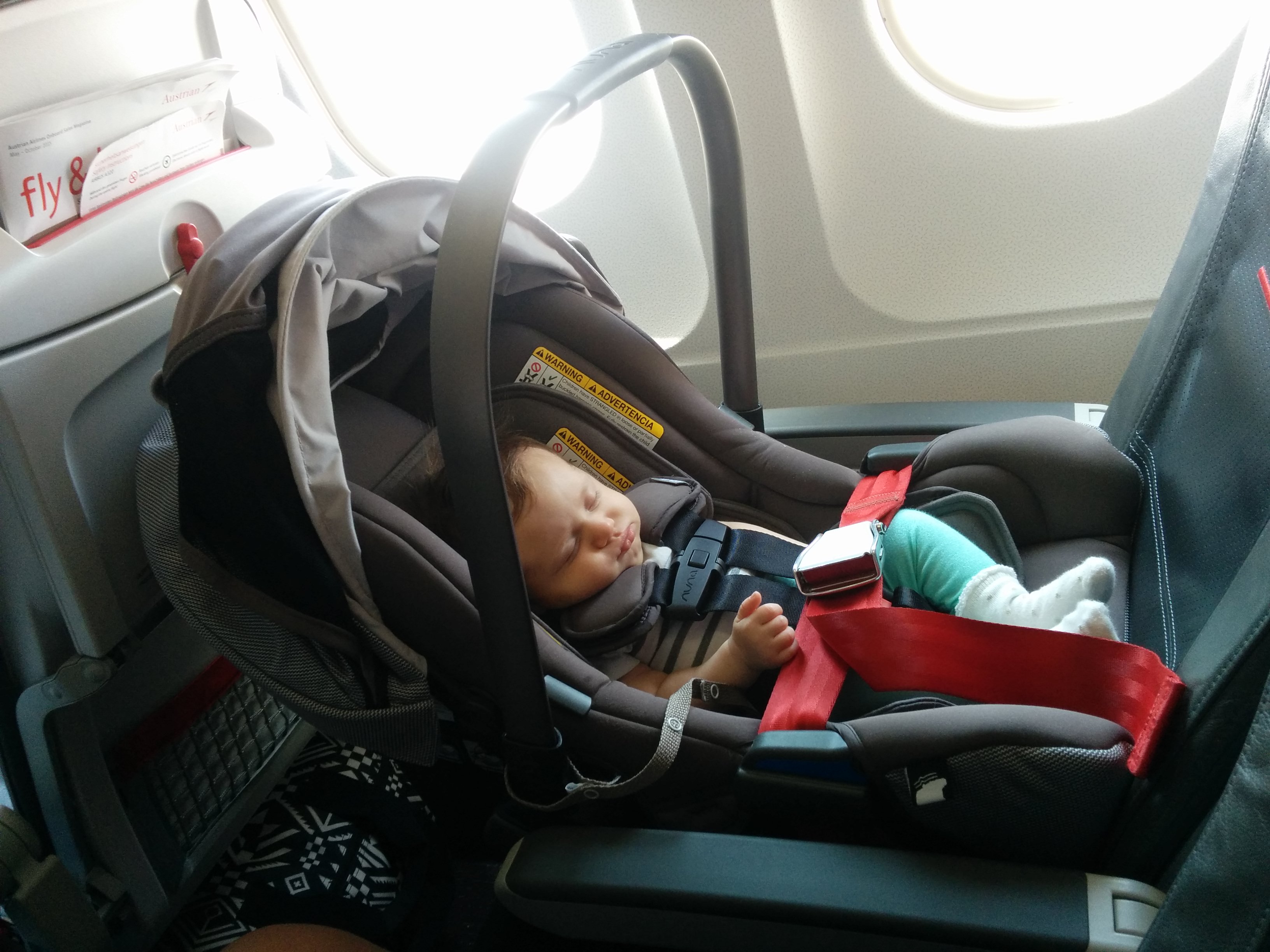 Luna in infant car seat (group 0+)
Luna in infant car seat (group 0+)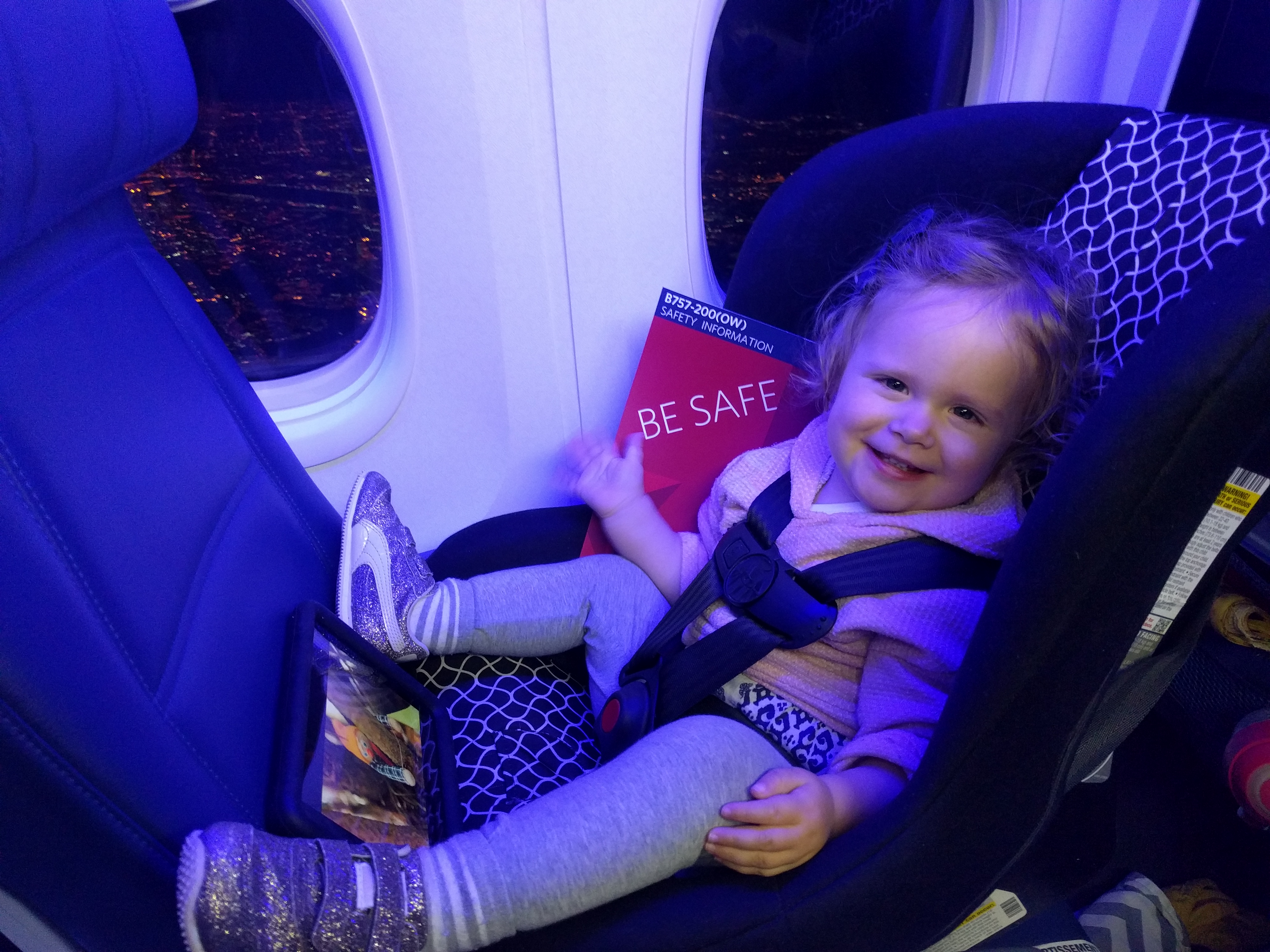 Luna in convertible car seat (group 0+/1)
Luna in convertible car seat (group 0+/1)
Prior to flying checklist
When booking your flight
- Book a ticket for your infant by selecting “infant in seat” instead of “infant in lap”.
- Try to reserve window seat for your infant. This is because the car seat can not impede possible evacuation (FAA regulation). If you fly with a US based airline which charges for seat reservations, you do not need to reserve the window seat and pay for it. FAA regulations pretty much guarantee that your infant will be given a window seat and you will sit right next to it, even if someone else purchased a seat assignment for that window seat. But you must be prepared to fight for your rights with uninformed crew (see below how). Avoid booking window seats in or near exit row and in bulkhead row.
- To increase your chances of walking away from a survivable crash, pick seats in the very back of the airplane, where the G forces are smallest during a crash, as documented in this fantastic documentary.
Prior to boarding
- Check the boarding pass. If it lists your infant as a lap infant, go back to the ticket counter or a gate and insist on a getting a corrected boarding pass with a unique seat number. If you bring a “lap infant” boarding pass on board, you might be denied from using the seat for your infant, as happened to the Schear family just few days ago.
- Make sure your seat is right next to the infant’s seat.
- If the boarding pass does not indicate that the child has a window seat, approach the check-in agent or a gate agent and ask them to assign a window seat for your infant. If they object, and the airline is registered with FAA, point them to the following FAA advisory circular which contains regulations they are required to obey. Point them to section 19 in the document. Do not wait until you board. Make sure your child has a window seat prior to boarding.
Bring the following with you on board
- Most important document to print and bring to a US airline is this FAA advisory circular memo is with regulations about child restraints. All airlines registered with FAA are required to follow these regulations and luckily, this document is very clear about rear facing (aft facing) car seats and how to accommodate these. You can reference this memo when arguing with uninformed flight attendants. You are most likely going to be able to reason with them if you have the regulations printed with relevant sections highlighted for quick reference. If they keep pointing to their internal regulations, you can tell them that their internal regulations are in direct conflict with FAA regulations and you plan on reporting the airline to FAA which would subject the airline to investigation and possible fines as happened to Delta, American and United in 2012.
- Print and bring the airline’s child seat policy (which should be published on the airline’s website) and bring with you on board. These policies usually mention that FAA approved child seats are allowed, and some even mention rear facing car seats. These websites sometimes also mention that that the car seat needs to be installed according to manufacturer instructions for the child’s age and height (which translates to rear facing!).
- Bring your car seat manual booklet and know which page the airplane specific installation instructions are on. Remember, you need to be able to quickly open it on the right page when the flight attendant is asking you to turn the car seat forward. Show them that this car seat is FAA approved and its instructions clearly explain how to install it rear facing on an airplane. Manuals for convertible car seats also clearly state that the child must be at least two years of age before it can be installed forward facing.
- DO NOT BRING BOOSTER SEATS ON BOARD. The purpose of booster cushions is to raise kid's upper body to allow them to use a car shoulder belt. Airplanes have lap belts. FAA prohibits the use of booster seats on board.
When boarding
- Know where FAA label sticker is on your car seat. The label shoud say in red “This Restraint is Certified for Use in Motor Vehicles and Aircraft”. Don’t look for the FAA acronym. You won’t find it. Make sure to point it to the flight attendant at the gate and also the one that is serving your isle.
- Ask whether there is any portion of the flight above any larger body of water. If so, ask if you can get infant life vest right now, or whether they hand it out during the ditching procedure (when airplane is heading down towards the water).
- Inform the passenger that sits in front of the car seat that they will not be able to recline. If they have a problem with it, they can be asked to be reseated before takeoff. You can be extra nice and offer them a free drink. I have a workaround around inconveniencing the passenger in front of the car seat. I simply bring a convertible car seat which I install properly (rear facing) for takeoff and landing, and then turn it around and install it forward facing during the cruise portion of the flight. This has two advantages: #1 the person in front of the car seat can recline, and #2 the car seat itself can recline as well, allowing your baby to sleep better. I usually inform the person in front of the car seat that they might not recline during takeoff and landing but later they will be able to. And I ask them to be careful to not recline suddenly and pinch my baby’s legs.
Additional steps when flying with non-US based airlines
If your airline is not registered with FAA, I recommend you do the following in addition to steps above:
Contact the customer service in writing/email and ask them the following:
- Do you allow FAA approved car seats on board of your airplanes <airplane model> from <origin city> to <destination city>?
- Will you allow me to bring my <brand name> car seat on board if I purchase a ticket for my infant?
- Will I be allowed to install it rear facing direction (according to manufacturer instructions for infants under 2) on a forward facing airplane seat?
- Will the infant be allowed to sit in the car seat during take off and landing and anytime seatbelt sign is on? I do not intend to use a baby loop belt for takeoff and landing, and I do not intend to hold my baby while the seatbelt sign is on.
- Do I need to reserve the window seat ahead of time or will the gate staff make sure that my car seat does not impede evacuation? Will I need to pay extra for window seat assignment?
I have never received clear Yes/No responses to these questions so be prepared to have to go back and forth with the customer service and keep pushing until all questions are clearly answered. It might take you a couple of weeks to get all responses, so start early. Once you got satisfactory answers to your questions, you can purchase your tickets. Before flying, print and bring with you the entire conversation with customer service (underlining the important parts). You might need to show it to confused flight attendants. Sadly, I’m speaking from experience with Air Berlin, Austrian Airlines and Swiss Airlines.
Can someone fix this?
I would suggest few action items for airlines and FAA:
- airline safety directors should modify the internal safety rules to be less ambiguous about rear facing car seats
- airlines should retrain the crews about regulations relating to rear facing car seats
- FAA should listen to NTSB recommendation and finally ban lap babies. This would force all airlines to require car seats for all babies and rear facing car seats would become normalized.
Lastly, I would like to express deep disappointment in how airline crews treat parents who bring in car seats for their infants. I have gotten into a number of heated arguments over rules that should be THEIR job to know and follow. For Christ’s sake, I’ve already mentioned that my husband had a terrorist card pulled on him while trying to keep our baby safe (he told to a flight attendant that he will “take KLM down on Twitter”)!
Just because most parents choose to save money and keep their unrestrained babies on laps, it doesn’t mean that the seated babies do not deserve the same level of safety as the rest of the restrained passengers.
My daughter just turned two, which means that I am going on a hiatus from arguing about rear facing car seats until another baby arrives. But this fight is not over for many parents who will need to keep fighting until all babies are allowed, or even better, required to fly in the appropriate child restraint systems (CRSs). Good luck to you all!

Reader Comments